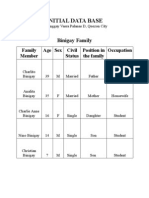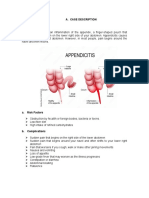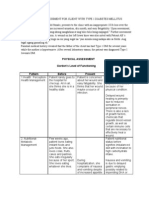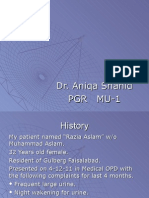Cholelithiasis Case Study
Cholelithiasis Case Study
Uploaded by
Sarah DentyCopyright:
Available Formats
Cholelithiasis Case Study
Cholelithiasis Case Study
Uploaded by
Sarah DentyCopyright
Available Formats
Share this document
Did you find this document useful?
Is this content inappropriate?
Copyright:
Available Formats
Cholelithiasis Case Study
Cholelithiasis Case Study
Uploaded by
Sarah DentyCopyright:
Available Formats
Cholelithiasis Interventions
I.INTRODUCTION Cholecystitis is an inflammation of the
gallbladder wall and nearby abdominal lining.
Cholecystitis is usually caused by a gallstone in the cystic
duct, the duct that connects the gallbladder to the
hepatic duct. The presence of gallstones in the
gallbladder is called cholelithiasis. Cholelithiasis is the
pathologic state of stones or calculi within the gallbladder
lumen. A common digestive disorder worldwide, the
annual overall cost of cholelithiasis is approximately $5
billion in the United States, where 75-80% of gallstones
are of the cholesterol type, and approximately 10-25% of
gallstones are bilirubinate of either black or brown
pigment. In Asia, pigmented stones predominate,
although recent studies have shown an increase in
cholesterol stones in the Far East. Gallstones are
crystalline structures formed by concretion (hardening) or
accretion(adherence of particles, accumulation) of normal
or abnormal bile constituents. According to various
theories, there are four possible explanations for stone
formation. First, bile may undergo a change in
composition. Second, gallbladder stasis may lead to bile
stasis. Third, infection may predispose a person to stone
formation. Fourth, genetics and demography can affect
stone formation. Risk factors associated with
development of gallstones include heredity, Obesity,
rapid weight loss, through diet or surgery, age over 60,
Native American or Mexican American racial makeup,
female gender-gallbladder disease is more common in
women than in men. Women with high estrogen levels, as
a result of pregnancy, hormone replacement therapy, or
the use of birth control pills, are at particularly high risk
for gallstone formation, Diet-Very low calorie diets,
prolonged fasting, and low-fiber /high-cholesterol/highstarch diets all may contribute to gallstone formation.
Sometimes, persons with gallbladder disease have few or
no symptoms. Others, however, will eventually develop
one or more of the following symptoms; (1) Frequent
bouts of indigestion, especially after eating fatty or
greasy foods, or certain vegetables such as cabbage,
radishes, or pickles, (2) Nausea and bloating (3) Attacks
of sharp pains in the upper right part of the abdomen.
This pain occurs when a gallstone causes a sometimes,
persons with gallbladder disease have few or no
symptoms.
Others ,however, will eventually develop one or more of
the following symptoms; (1) Frequent bouts of
indigestion, especially after eating fatty or greasy foods,
or certain vegetables such as cabbage, radishes, or
pickles, (2) Nausea and bloating (3) Attacks of sharp pain
blockage that prevents the gallbladder from emptying
(usually by obstructing the cystic duct). (4) Jaundice
(yellowing of the skin) may occur if a gallstone becomes
stuck in the common bile duct, which leads into the
intestine blocking the flow of bile from both the
gallbladder and the liver. This is a serious complication
and usually requires immediate treatment. The only
treatment that cures gallbladder disease is surgical
removal of the gallbladder, called cholecystectomy.
Generally, when stones are present and causing
symptoms, or when the gallbladder is infected and
inflamed, removal of the organ is usually necessary.
When the gallbladder is removed, the surgeon may
examine the bile ducts, sometimes with X rays, and
remove any stones that may be lodged there. The ducts
are not removed so that the liver can continue to secrete
bile into the intestine. Most patients experience no
further symptoms after cholecystectomy. However, mild
residual symptoms can occur, which can usually be
controlled with a special diet and medication
II.NURSING ASSESSMENT
A.Personal History
Mr. Aproniano Castro is a 56 year old male, a Filipino
citizen who resides at PulongSantol, Porac Pampanga. He
was born on January 22, 1950 at Pulong Santol, his
religious affiliation is Roman Catholic and he is married to
Mrs. Brigida M. Castro. He is a jeepney driver bound in
Porac-Angeles route. He is also the president of their
jeepneys association. Mr. Castro usually works for 10 to
12 hours a day usually around7am to 7 pm. He always
sleeps around 9 in the evening and wakes up at 6 in the
morning. His wife was the one who prepares him the
breakfast and the snack. He has day-offs but uses this
day in working as the president of the jeepney
association. He usually eats instant food and love eating
foods which has condiment like patis, vinegar and soy
sauce. He also love eating vegetable salads and fatty
salty food. He is not also choosy on the food he eats
because he really eat a lots. He seldom drinks alcohol and
smoke. Regarding the finances about health he is using
his wifes PHILHEALTH card to compensate the finances
needed. Family Health and Illness History
B.Family Health and Illness History
According to Mr. Castro that the familial disease he knows
that they have in their family was the hypertension that is
on his fathers side. His father died because of heart
attack and her mother died of natural cause. He also
added that cholecystitis is prone to their family, because
of one of his siblings also had acquired this disease.
C. History of Past and Present Illness This is the second
time Mr. Castro been admitted into this hospital (Porac
DistrictHospital). On his first admission into this hospital
he had undergone thyroidectomy operation, which is
almost 3 years ago. He had not experience any accident
and injuries, even though his job is prone to accident
particularly vehicular accident. He also added that he had
an asthma when he was 7 years old that lasts when he is
21 years old, his
Postop Interventions
The client is four (4) hour postoperative open
cholecystectomy. Which data warrant immediate
intervention by the nurse?
1. Absent bowel sounds in all four (4) quadrants
2. The T-tube has 60 Ml of green drainage
3. Urine output of 100 Ml in the past three (3) hours
4. Refusal to turn, deep, breathe, and cough
Answer: 4 Refusing to turn, deep breathe, and cough
places the client at risk for pneumonia. This client needs
immediate intervention to prevent complications
Medication Interventions
Fever
A patient is prescribed Primaxin 500 mg IV for a
temperature of 101.5 C. Before you give the antibiotic,
what will you assess?
Assess allergies, including allergies to cephalosporins
and penicillins, as cross-sensitivity might occur.
Assess for a history of seizure disorders because this
drug might cause seizures.
Check IV site and ensure patency.
Check the physician orders. Given the degree of
temperature elevation, the surgeon likely ordered pancultures for blood, urine cultures, and sputum cultures.
These need to be collected before the
antibiotic is begun.
Primaxin- contains cilastin and imipenem
Medical Interventions
10.endoscopic retrograde cholangiopancreatography
(ERCP) - a procedure that allows the physician to
diagnose and treat problems in the liver, gallbladder, bile
ducts, and pancreas. The procedure combines x-ray and
the use of an endoscope. A long, flexible, lighted tube.
The scope is guided through the patient's mouth and
throat, then through the esophagus, stomach, and
duodenum. The physician can examine the inside of
these organs and detect any abnormalities. A tube is then
passed through the scope, and a dye is injected which will
allow the internal organs to appear on an x-ray.
11.computed tomography scan (CT or CAT scan) - a
diagnostic imaging procedure using a combination of xrays and computer technology to produce cross-sectional
images (often called slices), both horizontally and
vertically, of the body. A CT scan shows detailed images
of any part of the body, including the bones, muscles, fat,
and organs. CT scans are more detailed than general xrays.
12.Cholecystectomy- removal of the gallbladder. This
procedure may be performed to treat chronic or acute
cholecystitis, with or without cholelithiasis, to remove a
malignancy or to remove polyps.
13.Cholecystotomy- the establishment of an opening into
the gallbladder to allow drainage of the organ and
removal of stones. A tube is then placed in the
gallbladder to established external drainage. This is
performed when the patient cannot tolerate
cholecystectomy.
14.Choledochoscopy- the insertion of a choledoscope into
the common bile duct in order to directly visualize stones
and facilitate their extraction
You might also like
- Physical Education and Health 2Document11 pagesPhysical Education and Health 2Hazel EncarnacionNo ratings yet
- Pcap PathoDocument2 pagesPcap PathoLardel CarayNo ratings yet
- On Call Survival GuideDocument77 pagesOn Call Survival GuideSantanu SautyaNo ratings yet
- Chronic Kidney Disease Secondary To Type 2 Diabetes MellitusDocument84 pagesChronic Kidney Disease Secondary To Type 2 Diabetes Mellituswar5No ratings yet
- Open I Tibia Fibula (R) Lacerated Wounded Leg: Our Lady of Fatima UniversityDocument21 pagesOpen I Tibia Fibula (R) Lacerated Wounded Leg: Our Lady of Fatima UniversityPOTENCIANA MAROMANo ratings yet
- Cholelithiasis GRAND CASE PRESDocument52 pagesCholelithiasis GRAND CASE PRESKyle Cholo CholoNo ratings yet
- DM - Case Pres 1aDocument59 pagesDM - Case Pres 1abon clayNo ratings yet
- IDBDocument2 pagesIDBPaulo PolinagNo ratings yet
- Course in The WardDocument4 pagesCourse in The Wardenzomarfal100% (1)
- Cs AGNDocument177 pagesCs AGNMa Rafaela Rosales PalomponNo ratings yet
- Alvarez, Case Study CKDDocument17 pagesAlvarez, Case Study CKDErryl Justine AdvinculaNo ratings yet
- Diabetes Mellitus Case StudyDocument2 pagesDiabetes Mellitus Case StudyCLaire Cabahug CaseroNo ratings yet
- Chronic Obstructive Pulmonary DiseaseDocument76 pagesChronic Obstructive Pulmonary DiseasedidinNo ratings yet
- DRUGSTUDY NardilDocument2 pagesDRUGSTUDY Nardiljanelle tapiruNo ratings yet
- Case Study Icu Sem 6Document30 pagesCase Study Icu Sem 6BM2-0619 Mohd Khairul Naaim Bin PenchariNo ratings yet
- Bea-Case StudyDocument21 pagesBea-Case Studybea pegadNo ratings yet
- Acute Cholecystolithiasis - G4 SB2Document125 pagesAcute Cholecystolithiasis - G4 SB2Jeofy PamaNo ratings yet
- DMDocument24 pagesDMJudeLaxNo ratings yet
- Acute Appendicitis Group CDocument40 pagesAcute Appendicitis Group CHeart TolenadaNo ratings yet
- Cu 3 Week 3Document3 pagesCu 3 Week 3Maica LectanaNo ratings yet
- NCP LeukemiaDocument5 pagesNCP LeukemiaTriciaNo ratings yet
- Hypertensive UrgencyDocument8 pagesHypertensive UrgencyTony A.No ratings yet
- Head Nurse Experience (Staffing)Document3 pagesHead Nurse Experience (Staffing)Abigail BrillantesNo ratings yet
- NCPDocument17 pagesNCPbalongetzNo ratings yet
- Jose Rizal University & Medical Center: KardexDocument2 pagesJose Rizal University & Medical Center: KardexMichael SarmientoNo ratings yet
- BSN4D-SG2 DM Type2Document201 pagesBSN4D-SG2 DM Type2Charisse CaydanNo ratings yet
- Case StudyDocument7 pagesCase StudyMicah Jonah ElicañoNo ratings yet
- Nursing Care PlanDocument3 pagesNursing Care PlanMae Therese AlabotNo ratings yet
- Physical Assessment For Patient With DM Type1Document4 pagesPhysical Assessment For Patient With DM Type1Mae AzoresNo ratings yet
- ETO NA TALAGA - Tapos Na Ang Lahat !!!Document32 pagesETO NA TALAGA - Tapos Na Ang Lahat !!!Keenen Engel Bonifacio Pascua100% (1)
- Case Pres Cerebrovascular DiseaseDocument34 pagesCase Pres Cerebrovascular DiseaseADRIATICO JAROSLUVNo ratings yet
- Upon Admission (15 PTS) in The Intensive Care Unit (15 PTS) : ? (5 Pts Each Parameter A Total of 15 Points)Document5 pagesUpon Admission (15 PTS) in The Intensive Care Unit (15 PTS) : ? (5 Pts Each Parameter A Total of 15 Points)Janelle Cabida SupnadNo ratings yet
- Nursing Care Plan: Subjective: During 8 Hours Nursing Management: (5) After 8 HoursDocument4 pagesNursing Care Plan: Subjective: During 8 Hours Nursing Management: (5) After 8 HoursRawan KhateebNo ratings yet
- Velez College of Nursing F. Ramos Street, Cebu CityDocument57 pagesVelez College of Nursing F. Ramos Street, Cebu Cityinah krizia lagueNo ratings yet
- Diabetes InsipidusDocument48 pagesDiabetes InsipidusAhmed Fraz MamoonNo ratings yet
- Final CholelithiasisDocument36 pagesFinal CholelithiasisRalph Pelegrino100% (2)
- NCP - Gestational HypertensionDocument3 pagesNCP - Gestational HypertensionCameron De GuzmanNo ratings yet
- NCP DMDocument21 pagesNCP DMKate ManalastasNo ratings yet
- Rle Module Rle Unit Week: Bachelor of Science in Nursing: Rle NCM 105 - Psychiatric NursingDocument6 pagesRle Module Rle Unit Week: Bachelor of Science in Nursing: Rle NCM 105 - Psychiatric NursingAllisson BeckersNo ratings yet
- Case Study SSSSDocument37 pagesCase Study SSSSsplakener100% (1)
- Diagnostic Test NursingDocument4 pagesDiagnostic Test NursingSuzette Rae TateNo ratings yet
- Au Di Minor Case Study Myasthenia GravisDocument17 pagesAu Di Minor Case Study Myasthenia Gravisapi-301816885No ratings yet
- Thyroid Lobectomy and IsthmusectomyDocument12 pagesThyroid Lobectomy and IsthmusectomyAgustina100% (1)
- Intracerebral Hemorrhage (CVA) : Angeles University Foundation College of Nursing A.Y. 2016-2017Document203 pagesIntracerebral Hemorrhage (CVA) : Angeles University Foundation College of Nursing A.Y. 2016-2017Reisabelle LabianoNo ratings yet
- NCP Episiotomy WoundDocument3 pagesNCP Episiotomy WoundJP2001No ratings yet
- Case Stude NNJDocument6 pagesCase Stude NNJmuzamirNo ratings yet
- Case Study COPDDocument2 pagesCase Study COPDNicole SimoneNo ratings yet
- Case Study: Breast CancerDocument72 pagesCase Study: Breast CancerJoy Mariel Isadora BurgosNo ratings yet
- Nursing Care PlanDocument13 pagesNursing Care Planyumiko0% (1)
- Case Study On Bilateral NephrolithiasisDocument84 pagesCase Study On Bilateral NephrolithiasisSteph BulanNo ratings yet
- A Review: Nutrition in Chronic Kidney Disease PatientsDocument13 pagesA Review: Nutrition in Chronic Kidney Disease Patientsscience worldNo ratings yet
- NRG 302 13a G2 Copar ModuleDocument14 pagesNRG 302 13a G2 Copar ModuleRhea CruzNo ratings yet
- Case StudyDocument26 pagesCase Studyamazing grace mejia carlos100% (2)
- Case Study MijaresDocument55 pagesCase Study Mijaresiura echinNo ratings yet
- Preliterate Times The Medieval Period: Era of Magico - Religious Explanation Era of AlienationDocument6 pagesPreliterate Times The Medieval Period: Era of Magico - Religious Explanation Era of AlienationJezreel Joyce RufiñoNo ratings yet
- Physical Exam - AppendectomyDocument8 pagesPhysical Exam - Appendectomyirish felixNo ratings yet
- Insulin GlargineDocument2 pagesInsulin GlarginePatricia MaglasangNo ratings yet
- Acute Kidney InjuryDocument6 pagesAcute Kidney Injurytherese BNo ratings yet
- LFD Med WardDocument2 pagesLFD Med WardCarey Jamille YadanNo ratings yet
- Ventricular Septal Defect, A Simple Guide To The Condition, Treatment And Related ConditionsFrom EverandVentricular Septal Defect, A Simple Guide To The Condition, Treatment And Related ConditionsNo ratings yet
- The Ride of Your Life: What I Learned about God, Love, and Adventure by Teaching My Son to Ride a BikeFrom EverandThe Ride of Your Life: What I Learned about God, Love, and Adventure by Teaching My Son to Ride a BikeRating: 4.5 out of 5 stars4.5/5 (2)
- Community Acquired Pneumonia, A Simple Guide To The Condition, Diagnosis, Treatment And Related ConditionsFrom EverandCommunity Acquired Pneumonia, A Simple Guide To The Condition, Diagnosis, Treatment And Related ConditionsNo ratings yet
- Approach To The Child With AnemiaDocument9 pagesApproach To The Child With Anemiasack26_11_93No ratings yet
- Tschauner - S Guide To Small Animal ClinicsDocument408 pagesTschauner - S Guide To Small Animal ClinicsRagil Angga Prastiya83% (6)
- MalariaDocument3 pagesMalariasuciNo ratings yet
- Conjunctivitis UpToDateDocument21 pagesConjunctivitis UpToDateRosejane MagauayNo ratings yet
- Lapkas HemoptisisDocument19 pagesLapkas HemoptisisDaniel IvanNo ratings yet
- PDF Connersx27 Adult Adhd Rating Scales CompressDocument2 pagesPDF Connersx27 Adult Adhd Rating Scales CompressLizethSolis0% (3)
- Therapeutic Diet To Control Different Types of DiseasesDocument79 pagesTherapeutic Diet To Control Different Types of DiseasesSouvik TewariNo ratings yet
- Kode Pintar Icd 10Document20 pagesKode Pintar Icd 10boventbNo ratings yet
- E-Book Ey11 National Ent 11032021Document192 pagesE-Book Ey11 National Ent 11032021Mihnea CondeescuNo ratings yet
- Fluanxol Depot: Name of MedicineDocument11 pagesFluanxol Depot: Name of MedicineIvo_NichtNo ratings yet
- Sekar KSP - Hypoglicemia Ec Tipe 2 DMDocument28 pagesSekar KSP - Hypoglicemia Ec Tipe 2 DMdianarahimmNo ratings yet
- Tdiagnostics - Telangana.gov - in ViewFiles - Aspx ReportId ENJz5ppLrQAtvg2pdpA4nwDocument7 pagesTdiagnostics - Telangana.gov - in ViewFiles - Aspx ReportId ENJz5ppLrQAtvg2pdpA4nwjohnrabbits42No ratings yet
- B2 U6 Extra Grammar Practice ReinforcementDocument1 pageB2 U6 Extra Grammar Practice ReinforcementirinachircevNo ratings yet
- Physiology of MenopauseDocument21 pagesPhysiology of MenopauseHellenKyakuwaire100% (1)
- 8-Human Health and Disease Extra Questions-1Document14 pages8-Human Health and Disease Extra Questions-1Poonam PathakNo ratings yet
- 52 Somatic Symptom IbrahimDocument50 pages52 Somatic Symptom Ibrahimngocd6304No ratings yet
- Dr. Rosalia Sri Sulistijawati, M.SC, SP - Rad (K) : PembimbingDocument18 pagesDr. Rosalia Sri Sulistijawati, M.SC, SP - Rad (K) : PembimbingririazwarNo ratings yet
- 21 - Jaseca SandersDocument13 pages21 - Jaseca SandersRithu SanthoshNo ratings yet
- No. No. of MCQ 'SDocument16 pagesNo. No. of MCQ 'SUddhav KumbharNo ratings yet
- Airway Management For ResidentsDocument84 pagesAirway Management For ResidentsAbdulrahman DardeerNo ratings yet
- Seroquel (Quetiapine)Document3 pagesSeroquel (Quetiapine)E100% (1)
- Chap29 Quizlet 2Document6 pagesChap29 Quizlet 2bartolomemary1No ratings yet
- Ambulatory Medical ReportDocument2 pagesAmbulatory Medical ReportEdwin Ƿaniel Vargas RodríguezNo ratings yet
- Lecture Note On Renal Diseases For Medical Students - GNDocument10 pagesLecture Note On Renal Diseases For Medical Students - GNEsayas KebedeNo ratings yet
- 2.4.4.5c Acute PancreatitisDocument38 pages2.4.4.5c Acute PancreatitisAlfathush ShalihahNo ratings yet
- Manaka HammerDocument2 pagesManaka Hammerjhonny100% (3)
- Inotropes in PicuDocument2 pagesInotropes in PicuDijattxNo ratings yet
- Konsep Dasar PenyakitDocument14 pagesKonsep Dasar PenyakitAnnisa FadilasariNo ratings yet

























































































